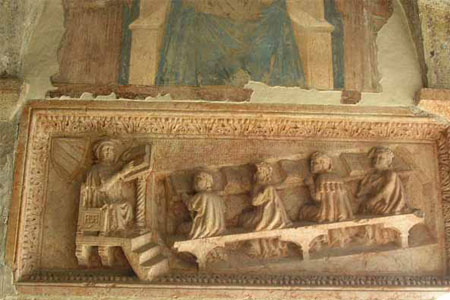- Autori:
-
Vermiglio, Elisa
- Titolo:
-
Post-mortem histopathological investigation in forensic medicine: focus on bone marrow sampling and processing
- Anno:
-
2019
- Tipologia prodotto:
-
Doctoral Thesis
- Lingua:
-
Inglese
- Parole chiave:
-
bone marrow, post-mortem examination, sampling, processig
- Abstract (italiano):
- Background. We sought to investigate a series of bone marrow specimens from forensic autopsies, with focus on post-mortem morphological changes and utility of the immunophenotypical analysis for medical-legal purposes. Materials and Methods. Thirty-six samples of the sternum taken during autopsies were examined: 11 samples were taken from subjects who died due to suspected drowning, in the period 2015-2017; the samples were placed inside a plastic con-tainer and stored in the freezer (-20C°) without being subjected to further treat-ments. 10 samples were taken from subjects who died due to several causes; the samples were fixed in formalin for a variable time; 15 samples were taken from non-forensic autopsies. H&E staining has been performed on all samples after decalcification&fixation. Morphological details has been categorized by three pathologists. Part of single sternum has been decalcified and fixed at different time (range in days). Decalci-fier I is a unique decalcifying solution that has the ability to fix and decalcify at the same time. Immunohistochemistry has been performed on all cases after inclusion of the fol-lowing commercially available antibodies: CD20, CD3, CD71, CD61, myelop-eroxidase and CD34 (commercially available clones). Data analysis has been per-formed by using both the Olympus BX51 microscope and D-Sight/Menarini Fluo-scan-scope, after digitalization of the glass slides (e-slide). Results. Overall, bone marrow samples were morphologically interpretable in 21/36 (58%) cases, were fully (after morphological and immunophenotypical data) interpretable in 22/36 (61%) cases, respectively 1/11 (9%) in the frozen samples, in 8/10 (80%) in the prospective day-by-day slow decalcified series and in 13/15 (87%) non-forensic series. All trilinear haematopoietic cells (myelo-erythroid cells and megakaryocytes) were detailed at both morphology and immunophenotypical levels in all groups expect in the frozen series, where the apoptotic degenerative tissue was observed. In the single cases (1/11%, 9%) of samples taken at frozen temperature resulted inter-pretable; cellularity and immunophenotypical characters such as distinction in be-tween myeloid and erythroid components were maintained. The rest of the frozen series (9 cases out of 11, 91%) allowed visualization of the overall bone marrow cellularity, without distinction of the single components. In the prospective day-by-day decalcified series 7/10 (70%) of cases were interpretable for histopatholo-gy. Cellularity and detailed cellular components (mielo-erythroid distinction and megakaryocytes) by using immunohistochemistry were distincted in 8/10 (80%). Immunophenotypical analysis may be well interpreted on tissue after slow decalci-fication and fixation within a 8-14 range days. Frozen samples are not recom-mended for histopathological evaluation and subsequent immunophenotypical analysis, due to diffuse absence of suitable tissue. CD71 was assessable as dots at frozen samples, without morphological details, and be evaluable as percentages of cells. CD71 in non-forensic and prospective cases was easily countable. CD3, CD20 and CD34 did not show any positivity in the frozen sternum, whereas in the remaining series showed immunoexpression according to appropriate specif-ic cells (T and B lymphoid and immature cells). Conclusions. We found that: 1. slow day-by-day decalcifying process usually let the bone marrow from sternum after forensic autopsies, be morphologically inter-pretable; 2. immunophenotypical analysis may be performed on tissue after slow decalcification and fixation usually within 8-14 days; 3. frozen samples are not recommended for histopathological evaluation. The above reported considerations lead to the following final conclusion. The sternum collection in forensic autopsies in order to evaluate the bone marrow is not mandatory in all the forensics cases. However it is recommended in all th
- Id prodotto:
-
108335
- Handle IRIS:
-
11562/994683
- ultima modifica:
-
3 novembre 2022
- Citazione bibliografica:
-
Vermiglio, Elisa,
Post-mortem histopathological investigation in forensic medicine: focus on bone marrow sampling and processing
Consulta la scheda completa presente nel
repository istituzionale della Ricerca di Ateneo 








